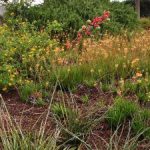What is a Xeriscape?
*** HOW TO PRONOUNCE “XERISCAPE” (zîr’ i˘-ska¯p‘) zer-i-scape ZIH-rih-skape Xeriscape is a trademarked term created by Denver Water. ***
A landscape is a xeriscape if it needs little extra water or other assistance to look its best. Fortunately, many plants thrive in San Antonio with these low-care conditions. This leaves a wide range of landscape styles at your fingertips. San Antonio low-water landscapes are cool, inviting and lush. They burst with color during every season of the year.
The San Antonio Botanical Garden has a “WaterSaver Lane” where you can observe many residential xeriscape. The styles modeled around tiny homes include: Wildscape, Manicured Xeriscape, Hill Country, Spanish Courtyard and Cottage Garden. One of these styles is bound to match your preferences and the architecture of your home.
How do I know if I have a xeriscape?
Having a Xeriscape is both what you have in your landscape and how you take care of it. Review the seven steps of xeriscape to determine which elements you already have in place. It is fairly simple to replace some turf grass, add mulch and learn to water efficiently.
Seven Xeriscape Steps
Planning
Think about what your landscape will look like during each season of the year. Will there be something attractive to look at even during the winter months? How will you use that backyard? Will a hardscape patio area enhance your lifestyle? Perhaps an herb garden would be attractive and useful. Planning a landscape for maximum enjoyment means thinking about these questions and creating a plan to meet your needs.
Soil Analysis & Improvement
Know your soil before you plant. Having four to six inches of good soil is best, but may not be practical for the entire yard in certain parts our city. For instance, for those with very thin soil, sticking with native Hill Country plants is probably best. In areas well-amended with compost or areas with naturally deeper soils, some semi-tropical plants will do well. In any case, as a rule adding more organic material is better.
Plant Selection
Pick a good shade tree or two. Enjoy some native plants or ones well-adapted to our area. An extensive list of options is available at www.saws.org/conservation.
Turfgrass
Think about why you want some grass and where it will suit you best. Ideally no more than half of your landscape should be grass. Choose a grass type that is drought-tolerant. There are many attractive varieties available for our area that can survive dry periods when necessary. Having six inches of soil is particularly important for keeping any kind of grass healthy.
Efficient Irrigation
A wellplanned Xeriscape will need little supplemental irrigation once it is established. If you decide to invest in an in-ground irrigation system, plan one that allows you to water in distinct plant zones. Shade areas need much less water than sunny ones. Grass and perennials should not be included in the same zones because their need is so different. Work closely with a licensed irrigator and ask many questions about how you can water only where and when needed.
Use of Mulches
Laying down several inches of mulch in garden beds is an important investment. Mulch keeps plant roots cool during hot weather. It holds critical moisture. And, it helps control weeds that can take over gardens.
Appropriate Maintenance
Check out Garden Resources to sample typical maintenance tasks for each season.




